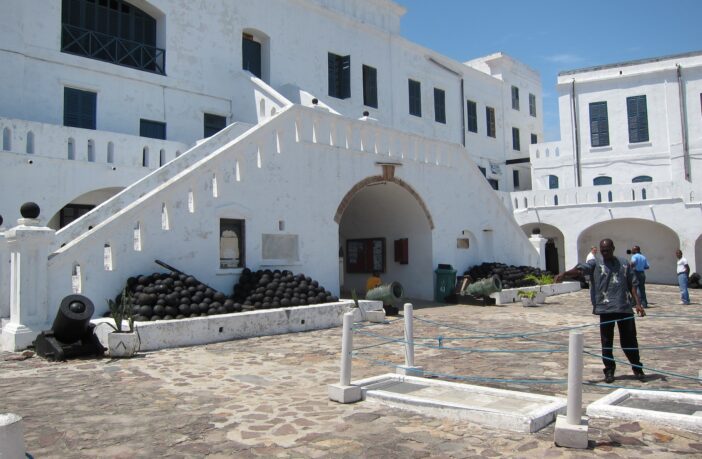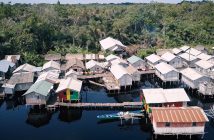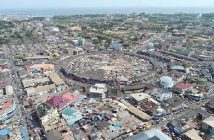Sadly, the mass dispersion of peoples from Africa during the Transatlantic Slave Trades from the 1500s to the 1800s, took away millions of people from Western and Central Africa to different regions throughout the Americas and the Caribbean.
But all hope is not lost because great historic places have still been kept for the purpose of going back to where our ancestors toiled as a great sacrifice, to survive.
The Cape Coast Castle
Cape Coast Castle is one of about forty “slave castles”, or large commercial forts, built on the Gold Coast of West Africa by European traders. It was originally a Portuguese “feitoria” or trading post, established in 1555. However, in 1653 the Swedish Africa Company constructed a timber fort there.
At the time enslaved Africans were a valuable commodity in America and slaves were the main trade in Cape Coast. Due to this, many changes were made to Cape Coast Castle. One of the alterations was the addition of large underground dungeons that could hold as many as a thousand slaves awaiting export. Many European nations flocked to Cape Coast in order to get a foothold in the slave trade. Business was very competitive, which led to conflict and for this reason the castle at Cape Coast changed hands many times during the course of its commercial history.
In Cape Coast Castle, the underground dungeon was a space of terror, death, and blackness. This stood as a direct opposition to the European living quarters and commanding heights of whiteness above, who lived relatively luxuriously. The basement of this imposing fortress was often the last memory slaves had of their homeland before being shipped off across the Atlantic, as this signified the beginning of their journey.
Cape Caost fishing hub – Abrofo Po Ano
This is the beach behind the Cape Coast castle in front of the door of no return. Previously considered as a secluded beach only for the whites in the colonial era, this beach today serves as the second arrival point for fishermen when they go fishing.
The Elmina Castle
Elmina Castle was erected by the Portuguese in 1482 as Castelo de São Jorge da Mina (St. George of the Mine Castle), also known as Castelo da Mina or simply Mina (or Feitoria da Mina), in present-day Elmina, Ghana (formerly the Gold Coast). It was the first trading post built on the Gulf of Guinea, and the oldest European building in existence south of the Sahara.[1] First established as a trade settlement, the castle later became one of the most important stops on the route of the Atlantic slave trade.
The Dutch seized the fort from the Portuguese in 1637, after an unsuccessful attempt to the same extent in 1596, and took over all of the Portuguese Gold Coast in 1642. The slave trade continued under the Dutch until 1814. In 1872, the Dutch Gold Coast, including the fort, became a possession of Great Britain.
The beginning of slave trade in Gold Coast, now Ghana, led to the use of the fort as a passage way for slaves to go through before the final sale to the Whites.
The fort just like many other forts for slave trade, had no water or sanitation, the floor of the dungeon was littered with human waste and many captives fell seriously ill. The men were separated from the women, and the captors regularly raped some of the helpless women. The castle also featured confinement cells — small pitch-black spaces for prisoners who revolted or were seen as rebellious. Once the slaves set foot in the castle, they could spend up to three months in captivity under these dreadful conditions before being shipped off to the New World.
The Komenda Sea Cave
The Komenda Sea Cave is a lovely tidal formation that is as a result of torrential waves hitting at a cliff and creating a big hallow curve. Rumour has it that, during the WW II the cave served as a hiding place for some members of the British Monarchy.
A visit to the cave serves an opportunity to observe how sandstone has been fractured and eaten up by torrential sea wave. You will also be amazed at how the cave stands as well as the number of people who can enter it.
Assin Manso Heritage site
The Assin Manso Ancestral Slave River Park which was one of the largest slave markets for gathering people to sell into slavery during the trans-Atlantic slave trade, shares many historic monuments and memories such as, the Ancestral graveyard, the last bath and the memorial wall of return.
The Assin Manso Ancestral Slave River Park, was the centre where slaves rested, bathed, were sorted out and resold, before they were transported through the Cape Coast and Elmina Castles to waiting ships bound for the Americans.
Captured Africans were forced to trek barefoot, through the harsh bush, headed to the Gold Coast Dungeon. They suffered abuse, were starved and beaten into compliance by the hired drivers of the slave merchant.
“They were often attacked by wild animals, but unable to fight or run because they remained shackled and chained.M any lives and spirits were lost along this hazardous journey”
(https://visitghana.com/directories/assin-manso-ancestral-slave-river-site/).
The Memorial Wall of return which is located in the Assin Manso Ancestral Slave river Park, is where most Africans write their names on the wall when they visit, indicating they have found their root. There is an inscription which pays tribute to some prominent people who were involved in slavery.
Make a date to stop by any of these places and be amazed.
REFERENCES
1. Available online at, https://en.m.wikipedia.org/wiki/Elmina_Castle
2. Available online at, https://en.m.wikipedia.org/wiki/Cape_Coast_Castle.





